Active Bearing Technology of Foot Steel Pipe Applied in Controlling the Large Deformation of Tunnels: A Case Study
Abstract
:1. Introduction
2. Description of the Project
3. Active Bearing Concept of the FSP
3.1. FSP and Its Action Mechanism
3.2. The Problem of Passive Bearing of the FSP
3.3. The Concept and Method of the Active Bearing of Pre-Deformed FSP
4. Numerical Analysis of Active Bearing of the FSP
4.1. Numerical Model Building and Material Parameters
4.2. Analysis of Active Bearing Effect of the FSP
5. Field Application of Active Bearing of the FSP
5.1. Implementation Process of Active Bearing
5.2. Field Application Process of the FSP
5.3. Application Effect Analysis of the FSP
6. Conclusions
- (1)
- The bearing capacity process of the traditional FSP is slow, and the active bearing can provide the bearing capacity of the FSP as early as possible. Only when the surrounding rock settlement is large can the traditional FSP provide a large bearing capacity, while the active bearing can provide the bearing capacity in advance by preloading.
- (2)
- The nonlinear spring can be used to simulate the bearing capacity of the steel pipe when simulating the supporting effect of the FSP on the tunnel. The control effect of increasing the diameter of FSP on tunnel deformation is better than that of increasing the number of steel pipes. However, due to the limited bearing capacity of the steel pipe itself, the deformation of the surrounding rock cannot be largely controlled simply by increasing the number or diameter of the steel pipe, and other auxiliary measures need to be taken.
- (3)
- The self-designed loading support realizes the active bearing of FSP can completely fit the size of any arch and grid steel frame. After the construction of the arch frame and FSP is completed manually, the preloading process at the end of FSP can be quickly carried out during tunnel construction by selecting a suitable type of loading device.
- (4)
- By adopting the active bearing method of FSP, the settlement rate of the arch vault can be significantly reduced within 1~2 days, which can be reduced by about 70%. The settlement of the arch vault can be reduced by more than 50% within 1~3 days. Therefore, the active bearing technology of FSP can provide a large bearing capacity at the initial stage of the surrounding rock deformation. It has a positive effect on reducing the overall deformation of the surrounding rock, slowing down the release of the surrounding rock pressure, and controlling the settlement of the arch vault.
Author Contributions
Funding
Institutional Review Board Statement
Informed Consent Statement
Data Availability Statement
Conflicts of Interest
References
- Liang, Q.; Li, J.; Wu, X.; Zhou, A. Anisotropy of Q2 Loess in the Baijiapo Tunnel on the Lanyu Railway, China. Bull. Eng. Geol. Environ. 2016, 75, 109–124. [Google Scholar] [CrossRef]
- Derbyshire, E. Geological Hazards in Loess Terrain, with Particular Reference to the Loess Regions of China. Earth-Sci. Rev. 2001, 54, 231–260. [Google Scholar] [CrossRef]
- Zhao, Y.; He, H.W.; Li, P.F. Key Techniques for the Construction of High-Speed Railway Large-Section Loess Tunnels. Engineering 2018, 4, 193–205. [Google Scholar] [CrossRef]
- Chen, J.X.; Luo, Y.B.; Chen, L.J. Rewrite the History of Loess Tunnel Construction. China Highw. 2019, 11, 30–35. [Google Scholar] [CrossRef]
- Wu, Y.M.; Lü, K.C.; Xu, Y. Bearing behaviors of steel foot pipes for tunnels in soft foundation. Chin. J. Geotech. Eng. 2009, 31, 1825–1832. [Google Scholar]
- Luo, Y.B.; Chen, J.K. Mechanical characteristics and mechanical calculation model of tunnel feet-lock bolt in weak surrounding rock. Chin. J. Geotech. Eng. 2013, 35, 1519–1525. [Google Scholar]
- Chen, L.J. Bearing Behaviors of Control Measures for Foot Settlement of Tunnel Steel Arch; Dalian University of Technology: Dalian, China, 2016. [Google Scholar]
- Tzivakos, K.P.; Kavvadas, M.J. Numerical investigation of the ultimate lateral resistance of piles in soft clay. Front. Struct. Civ. Eng. 2014, 8, 194–200. [Google Scholar] [CrossRef]
- Chan, C.L.; Low, B.K. Reliability Analysis of Laterally Loaded Piles Involving Nonlinear Soil and Pile Behavior. J. Geotech. Geoenviron. Eng. 2009, 135, 431–443. [Google Scholar] [CrossRef]
- Georgiadis, K.; Georgiadis, M. Undrained Lateral Pile Response in Sloping Ground. J. Geotech. Geoenviron. Eng. 2010, 136, 1489–1500. [Google Scholar] [CrossRef]
- Chen, L.; Zhang, Y.; Ma, Z. Analytical approach for support mechanism of feet-lock pipe combined with steel frame in weak rock tunnels. KSCE J. Civ. Eng. 2016, 20, 2965–2980. [Google Scholar] [CrossRef]
- Cao, H.; Peng, L.; Lei, M.; Tang, Q.; Peng, L.; Chen, F. Calculation Model of Supporting System for Tunnel Under Shallow and Weak Surrounding Rock Considering the Synergistic Effects. Geotech. Geol. Eng. 2020, 38, 1379–1388. [Google Scholar] [CrossRef]
- Liang, H.R.; Wang, Y.; Yan, X.; Liu, J.; Peng, H.; Guo, X. Research on mechanical stability of feet-lock pipe and steel arch in soft rock tunnel. J. Beijing Jiaotong Univ. 2020, 44, 34–41. [Google Scholar]
- Cheng, Y.X. Study on Mechanism and Supporting Characteristic of Feet-Lock Pipe in Loess Tunnel; Lanzhou Jiaotong University: Lanzhou, China, 2015. [Google Scholar]
- Wu, Y.; Tian, C.; Xu, P.; Zhao, Z.; Zhang, J.; Wang, S. Design Optimization Method of Feet-Lock Steel Pipe for Soft-Rock Tunnel Based on Load-Deformation Coordination. Appl. Sci. 2022, 12, 3866. [Google Scholar] [CrossRef]
- Luo, Y.B.; Chen, J.X.; Yang, D.H.; Li, D. Experimental Study of Testing Technologies for Stress of Tunnel Foot Locking Bolts. Tunn. Constr. 2016, 36, 1435–1441. [Google Scholar]
- Wei, X.Y.; Wu, Y.M.; Wang, S.J.; Zhang, J.W.; Qu, J.B.; Liang, W.M.; HU, K.X. A Steel Pipe Active Loading Device for locking Foot of Tunnel Initial Support. CN Patent CN214944323U, 30 November 2021. [Google Scholar]

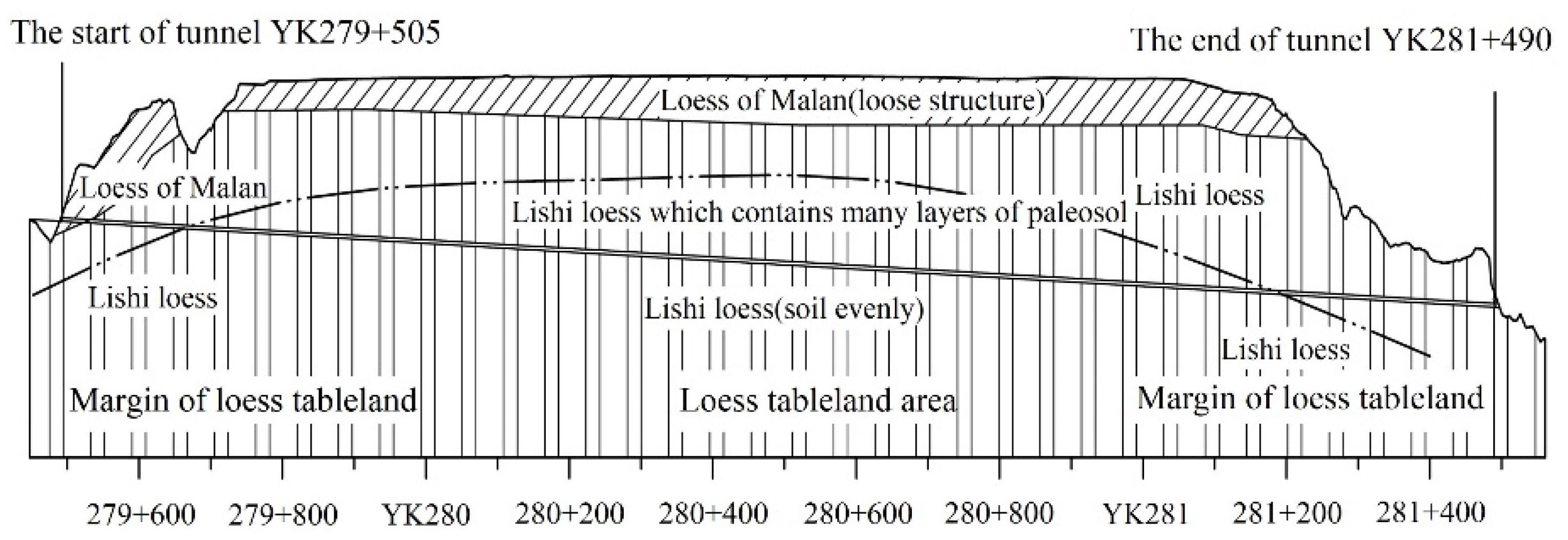

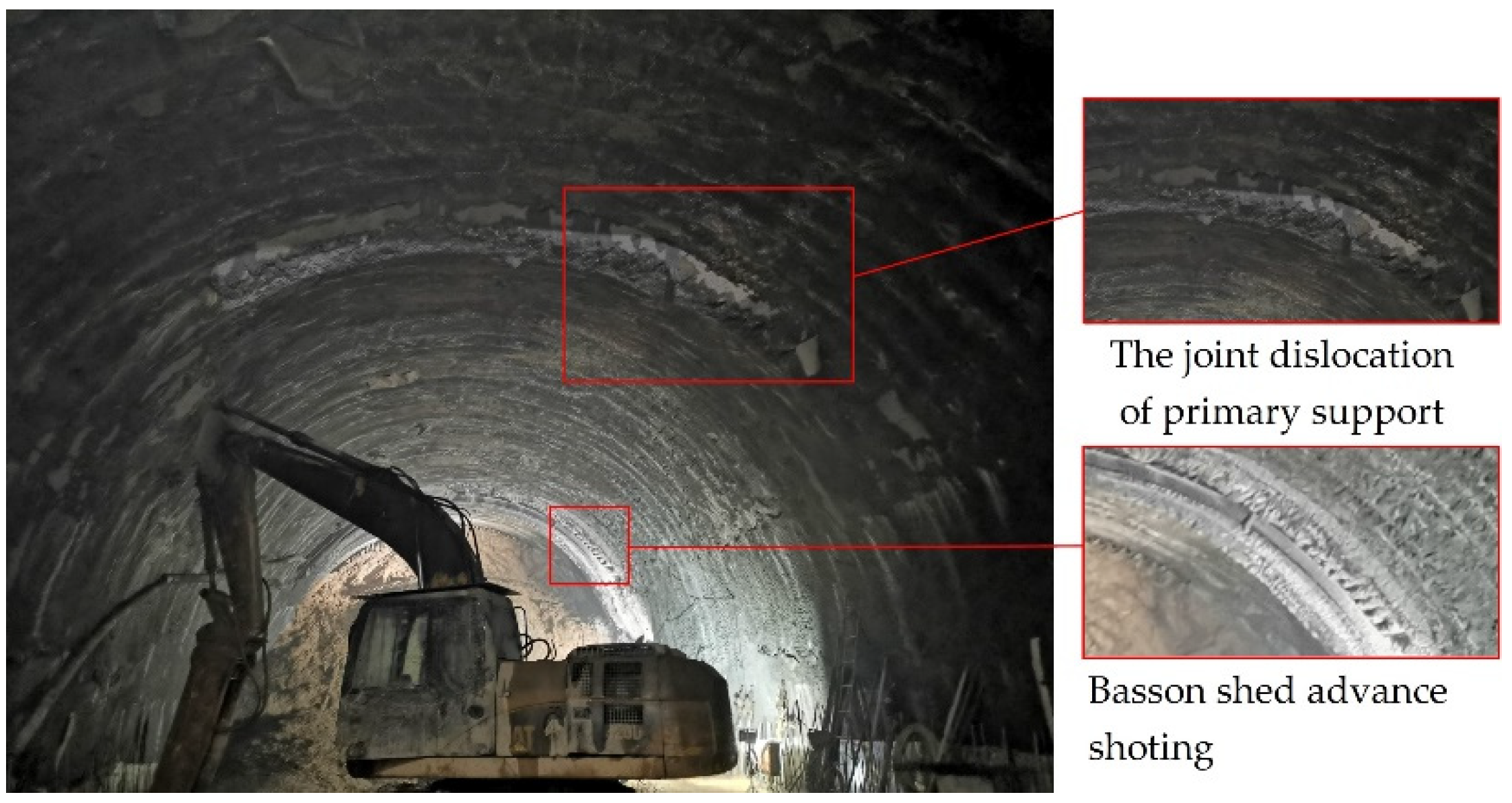

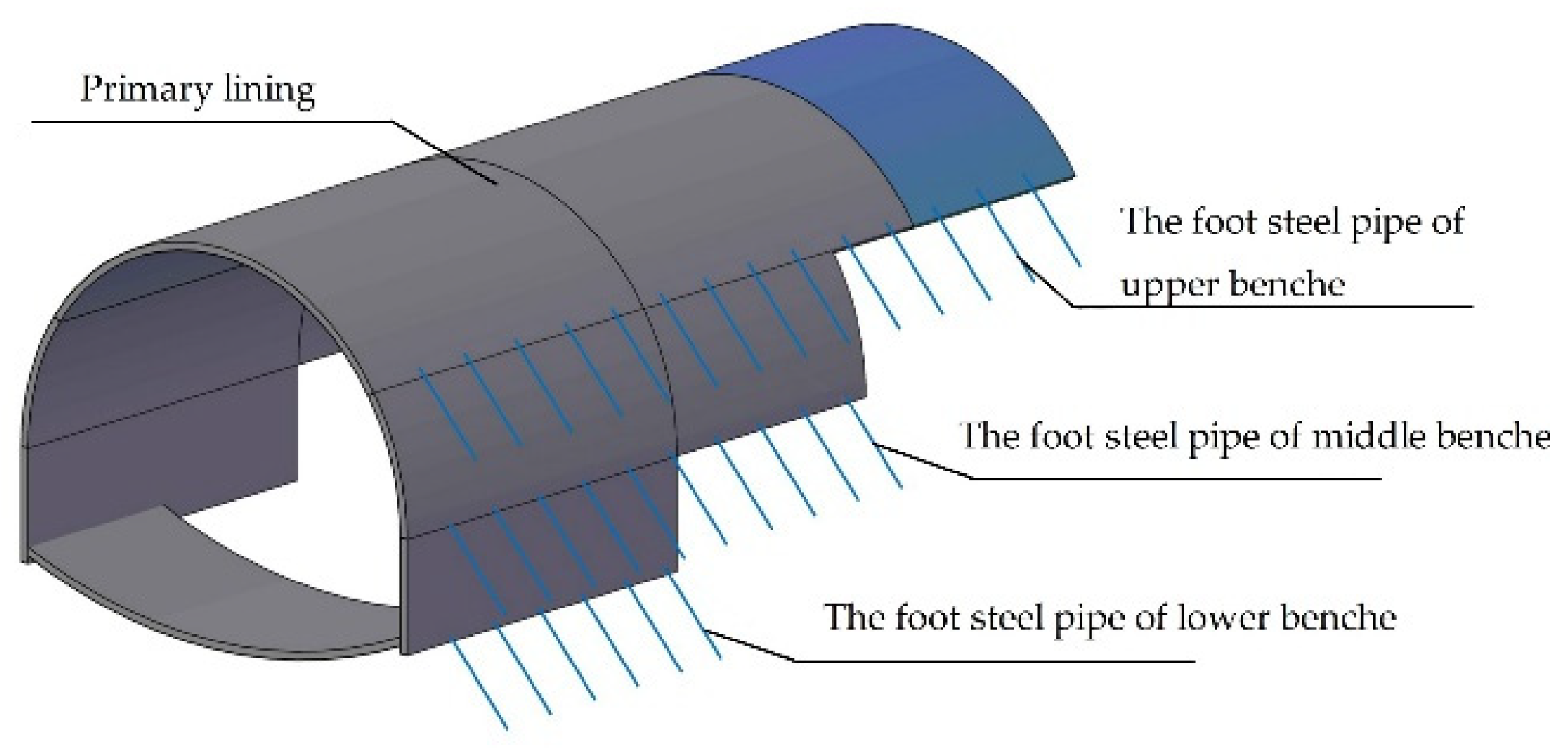

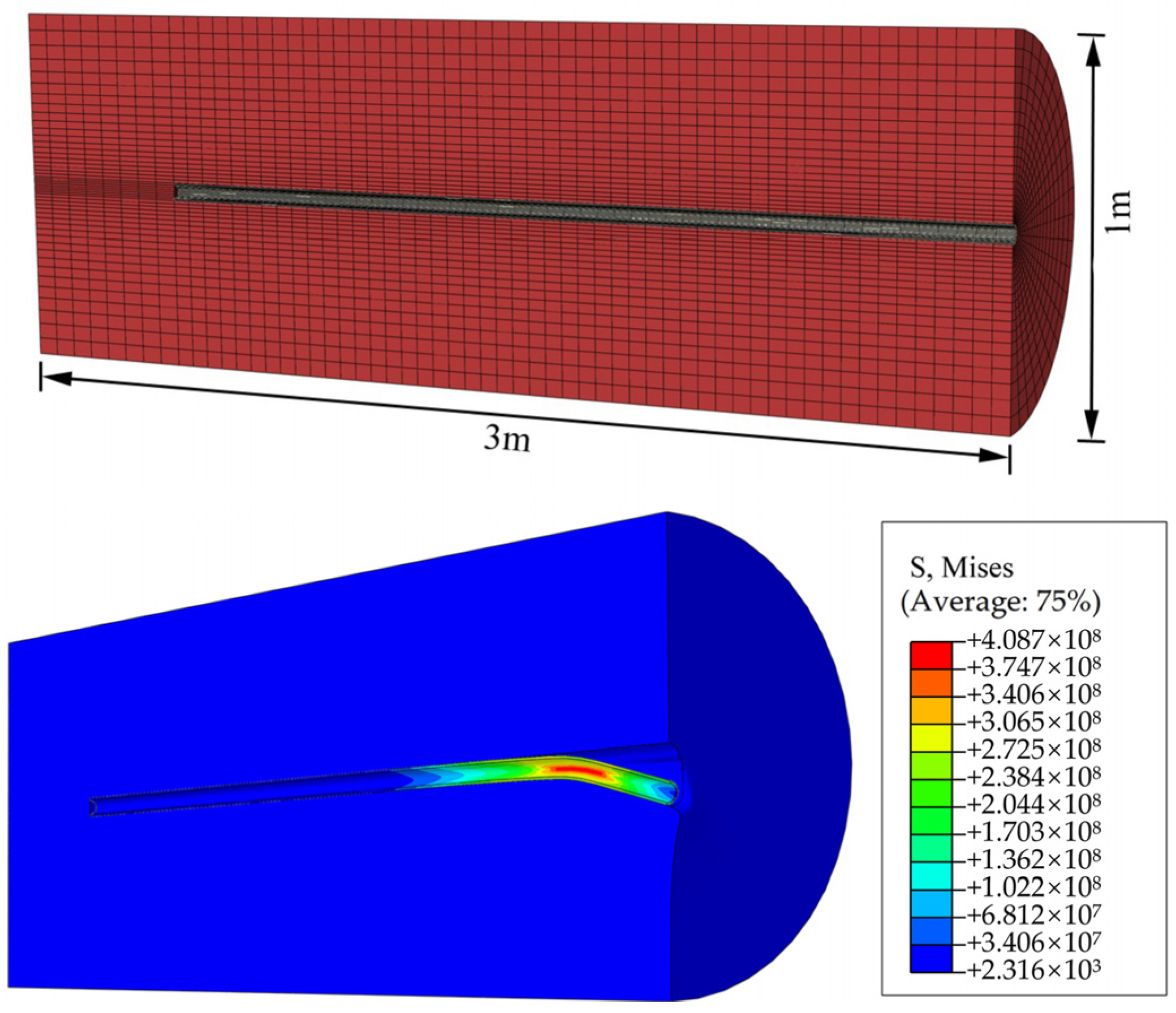


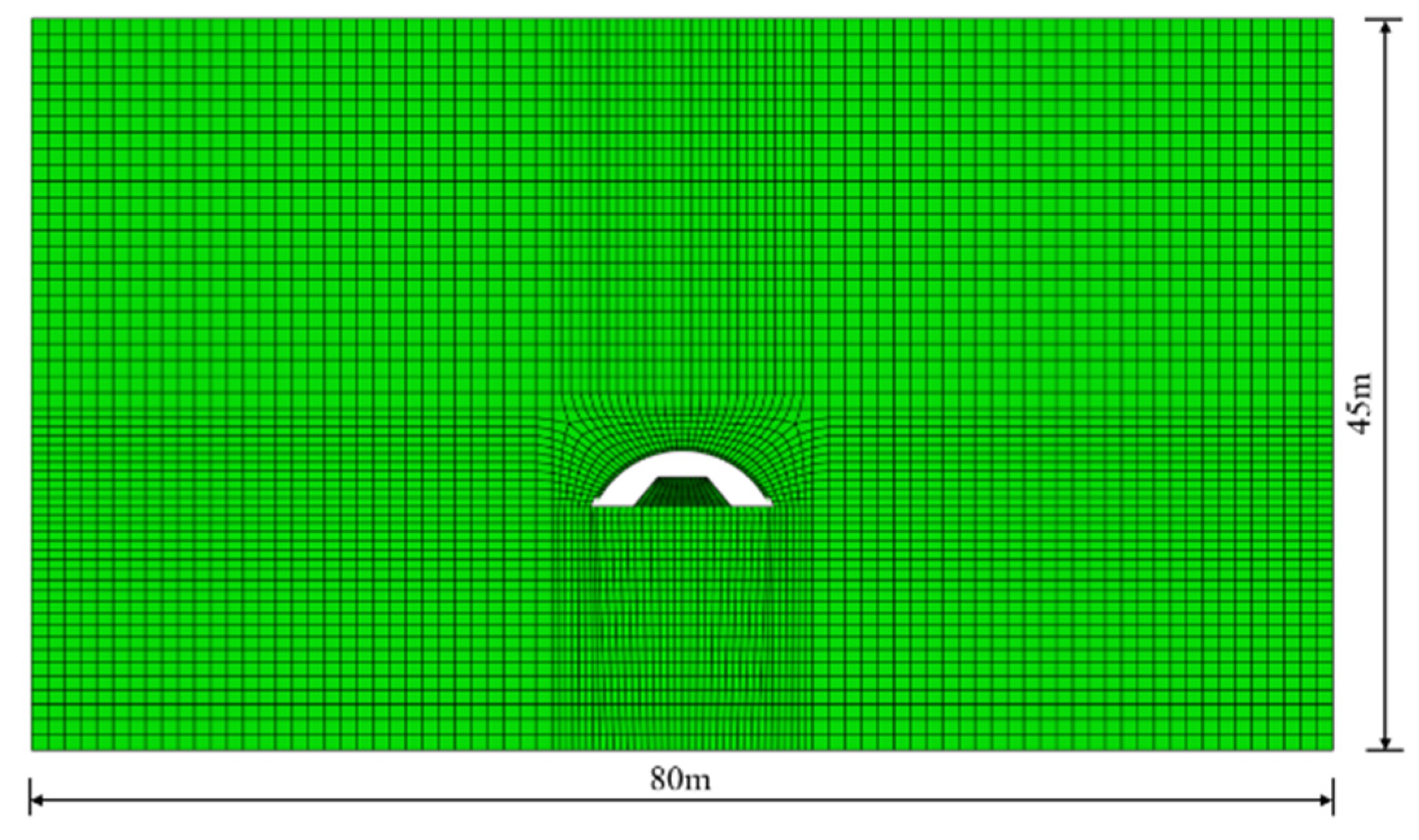
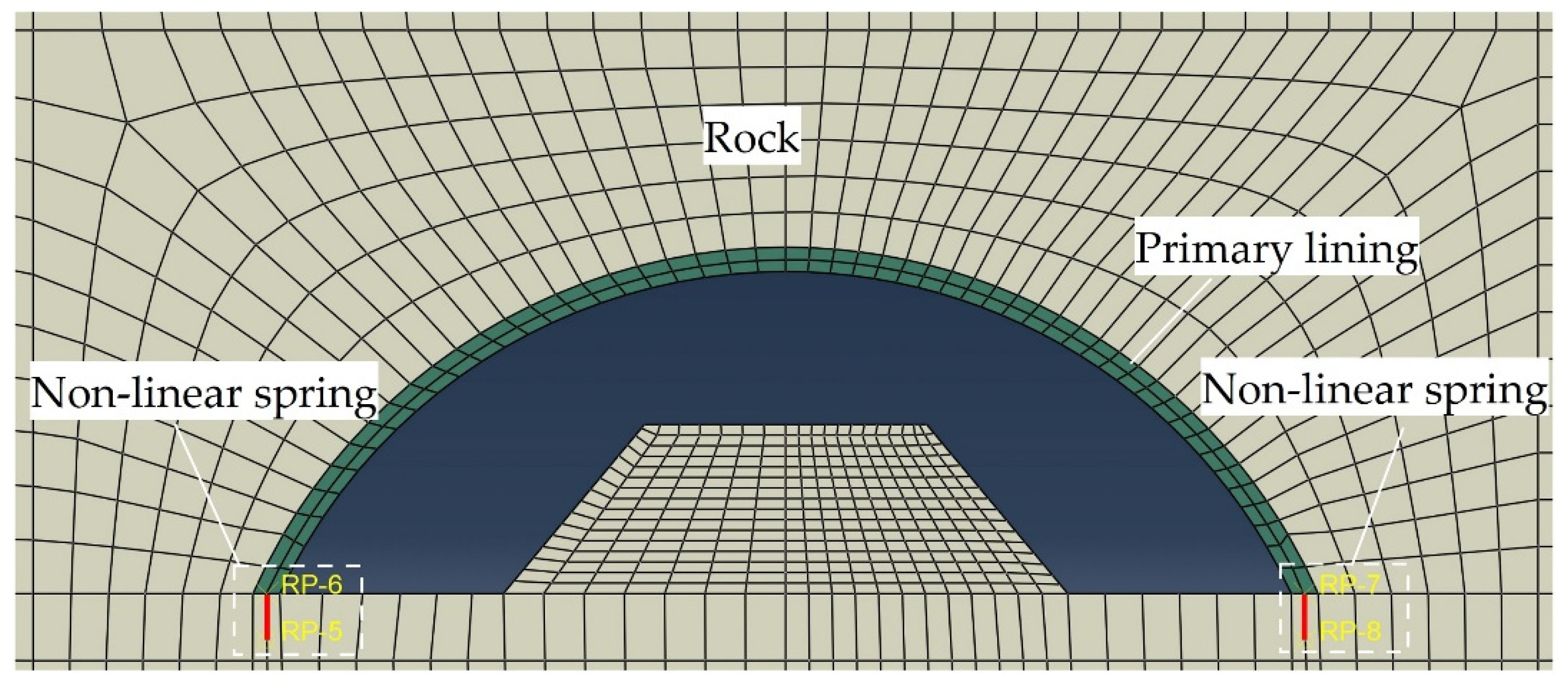
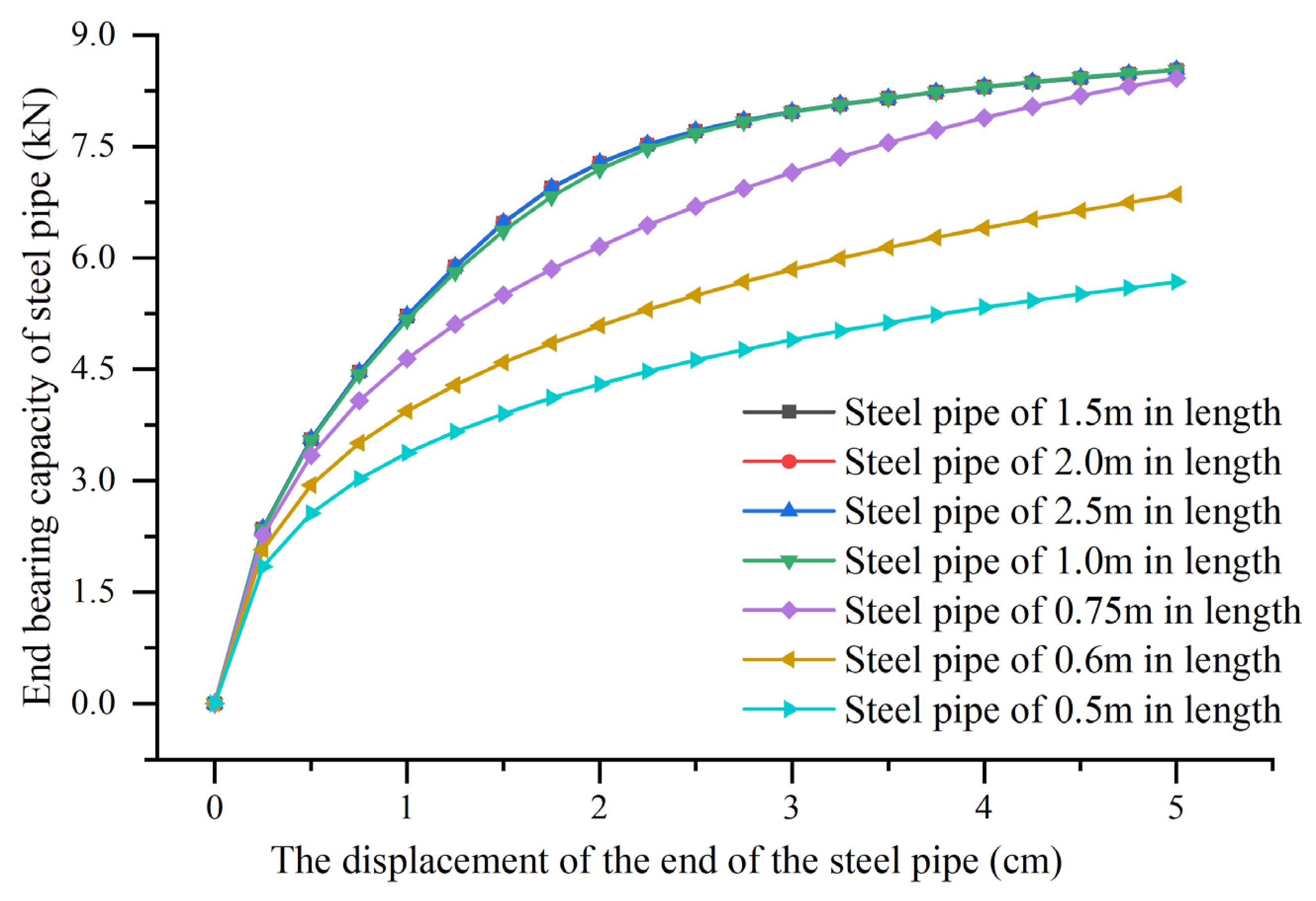


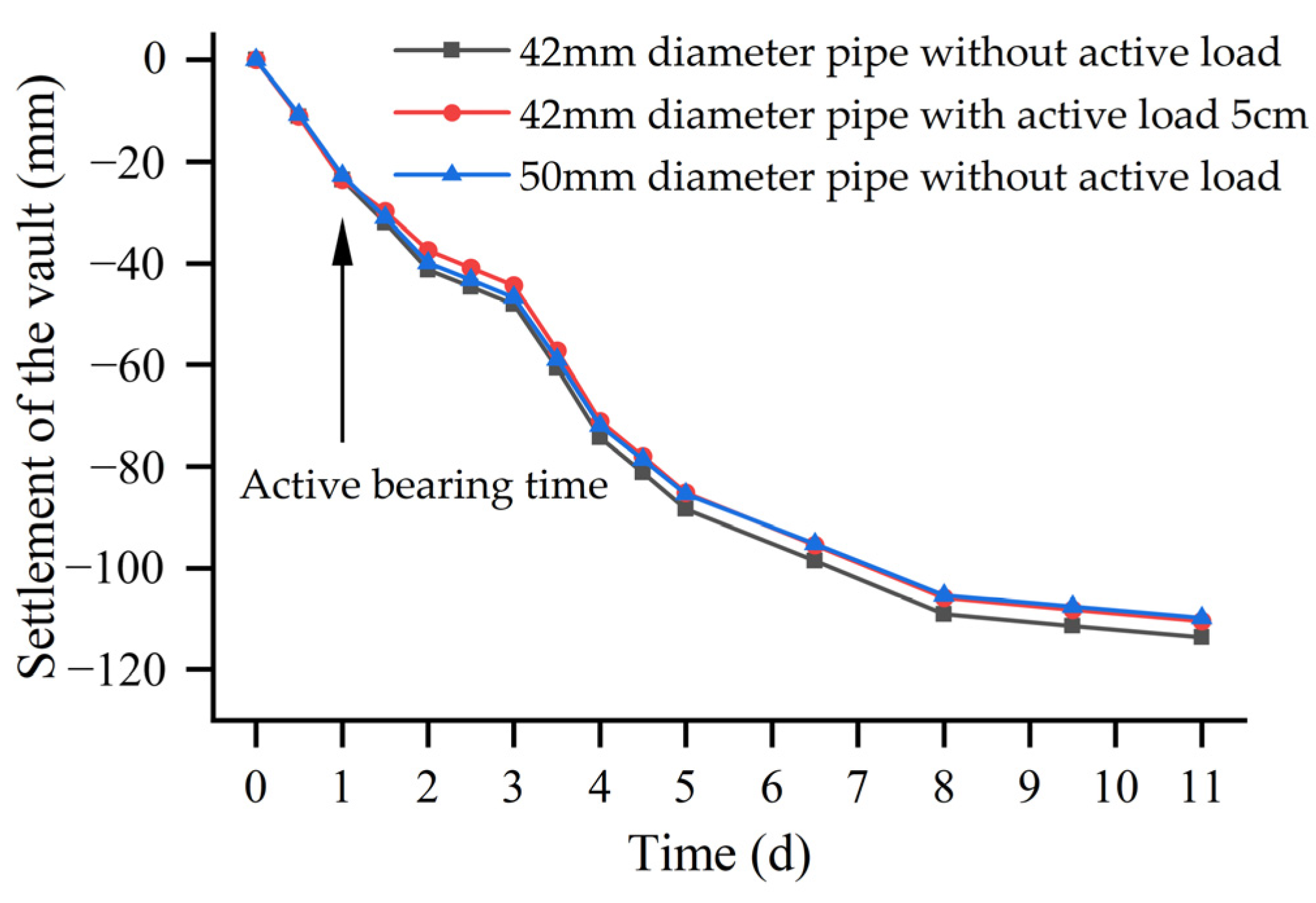
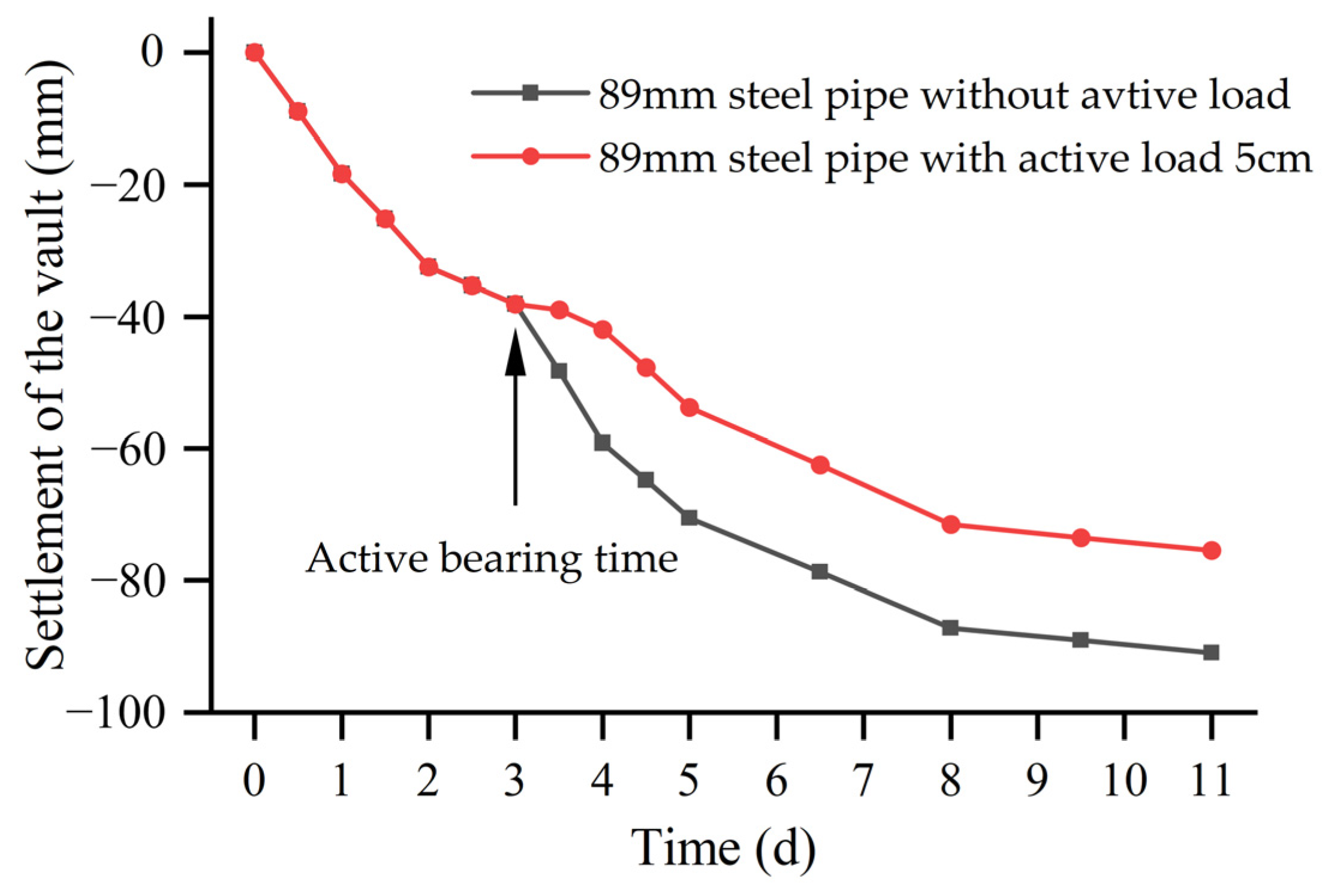


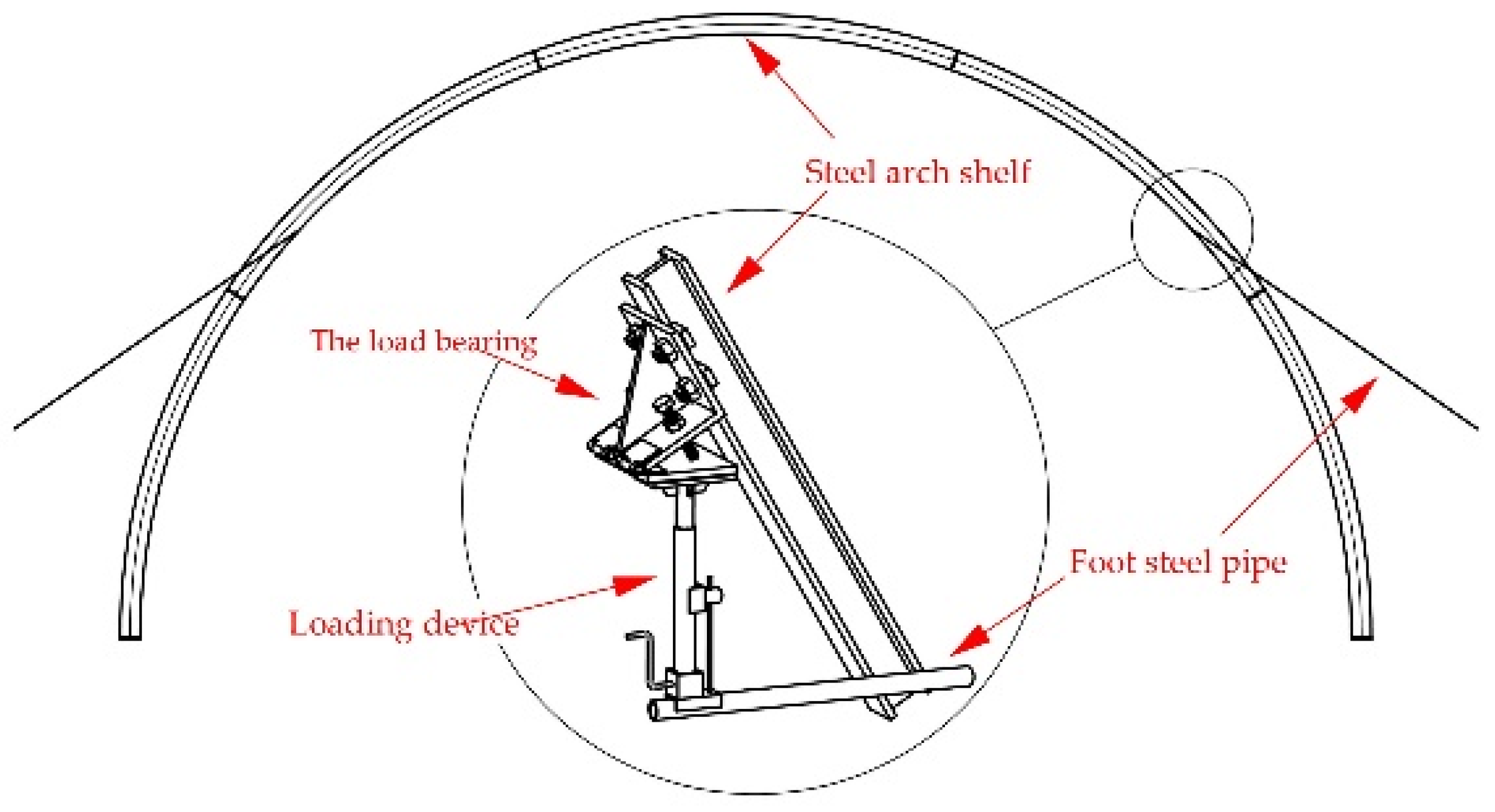
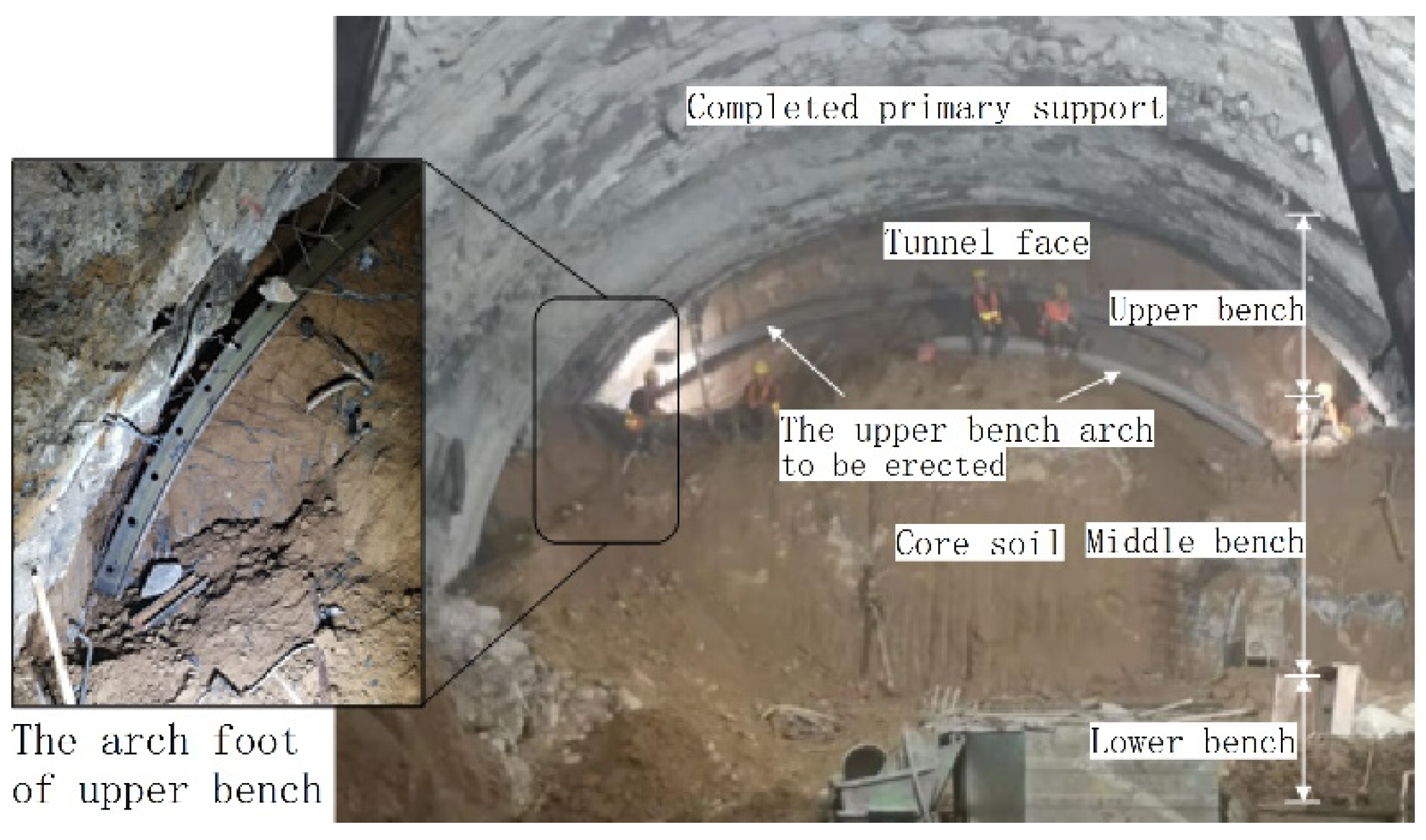


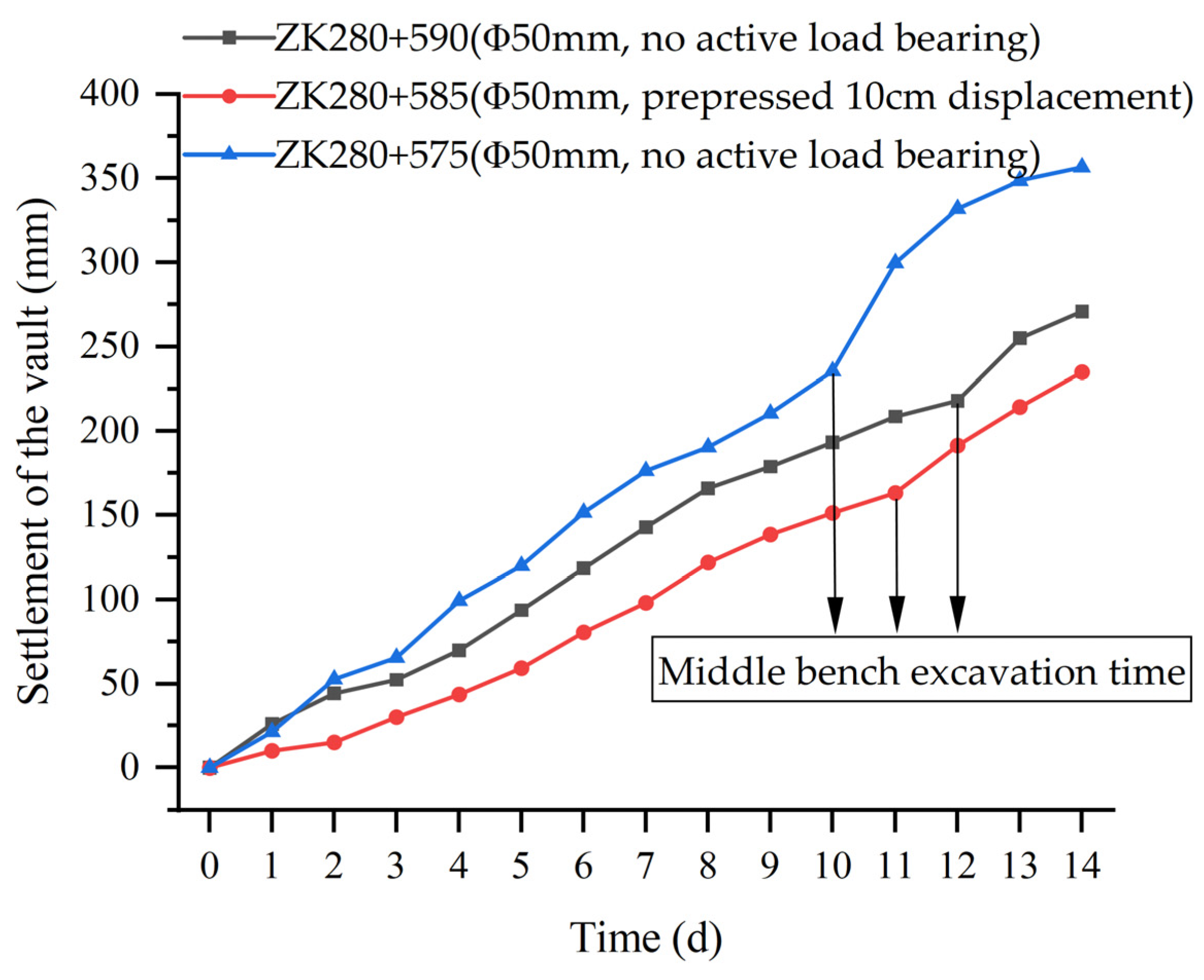
| Material | Density (kN/m3) | Elastic Modulus (MPa) | Poisson’s Ratio | Cohesive Forces (kPa) | The Angle of Internal Friction (°) | Constitutive Model |
|---|---|---|---|---|---|---|
| 15% water content of loess | 16 | 10 | 0.3 | 40 | 22 | M-C |
| 20% water content of loess | 16 | 8 | 0.3 | 16 | 22 | M-C |
| Foot steel pipe (HPB235) | 78 | 206,000 | 0.3 | yield stress: 235 MPa | elasticoplasticity | |
| Load Release Rate | The Normal State | Preload a Displacement of 5 cm at the End of the Steel Pipe | Preload a Displacement of 10 cm at the End of the Steel Pipe | ||
|---|---|---|---|---|---|
| Settlement of the Vault/mm | Settlement of the Vault/mm | Damping/% | Settlement of the Vault/mm | Damping/% | |
| 5% | 20.7257 | 18.3299 | 11.56 | 17.7929 | 14.15 |
| 10% | 46.9458 | 45.3057 | 3.49 | 44.9062 | 4.34 |
| 15% | 79.1534 | 78.4163 | 0.93 | 78.1401 | 1.28 |
| 20% | 115.958 | 115.535 | 0.36 | 115.493 | 0.40 |
| Load Release Rate | The Normal State | Preload a Displacement of 5 cm at the End of the Steel Pipe | Preload a Displacement of 10 cm at the End of the Steel Pipe | ||
|---|---|---|---|---|---|
| Settlement of the Vault/mm | Settlement of the Vault/mm | Damping/% | Settlement of the Vault/mm | Damping/% | |
| 5% | 20.0421 | 16.4076 | 18.13 | 15.1168 | 24.57 |
| 10% | 45.5087 | 42.4936 | 6.63 | 41.6787 | 8.42 |
| 15% | 76.6237 | 74.751 | 2.44 | 74.2158 | 3.14 |
| 20% | 112.01 | 111.23 | 0.70 | 111.084 | 0.83 |
| Load Release Rate | The Normal State | Preload a Displacement of 5 cm at the End of the Steel Pipe | Preload a Displacement of 10 cm at the End of the Steel Pipe | ||
|---|---|---|---|---|---|
| Settlement of the Vault/mm | Settlement of the Vault/mm | Damping/% | Settlement of the Vault/mm | Damping/% | |
| 5% | 16.1067 | 5.3998 | 66.47 | 0.0311 | 99.81 |
| 10% | 37.1501 | 27.3783 | 26.30 | 23.4207 | 36.96 |
| 15% | 63.0909 | 55.4235 | 12.15 | 52.9629 | 16.05 |
| 20% | 92.7426 | 88.2744 | 4.82 | 86.5692 | 6.66 |
| Load Release Rate | The Normal State | Preload a Displacement of 5 cm at the End of the Steel Pipe | Preload a Displacement of 10 cm at the End of the Steel Pipe | ||
|---|---|---|---|---|---|
| Settlement of the Vault/mm | Settlement of the Vault/mm | Damping/% | Settlement of the Vault/mm | Damping/% | |
| 5% | 18.6706 | 12.9227 | 30.79 | 10.8579 | 41.84 |
| 10% | 42.695 | 37.9235 | 11.18 | 36.5386 | 14.42 |
| 15% | 72.1146 | 68.9974 | 4.32 | 68.0879 | 5.58 |
| 20% | 105.973 | 104.522 | 1.37 | 104.124 | 1.74 |
Publisher’s Note: MDPI stays neutral with regard to jurisdictional claims in published maps and institutional affiliations. |
© 2022 by the authors. Licensee MDPI, Basel, Switzerland. This article is an open access article distributed under the terms and conditions of the Creative Commons Attribution (CC BY) license (https://creativecommons.org/licenses/by/4.0/).
Share and Cite
Zhao, Z.; Wu, Y.; Wang, L.; Hu, K.; Tian, C. Active Bearing Technology of Foot Steel Pipe Applied in Controlling the Large Deformation of Tunnels: A Case Study. Appl. Sci. 2022, 12, 11716. https://doi.org/10.3390/app122211716
Zhao Z, Wu Y, Wang L, Hu K, Tian C. Active Bearing Technology of Foot Steel Pipe Applied in Controlling the Large Deformation of Tunnels: A Case Study. Applied Sciences. 2022; 12(22):11716. https://doi.org/10.3390/app122211716
Chicago/Turabian StyleZhao, Zhizhong, Yimin Wu, Lin Wang, Kaixun Hu, and Changqing Tian. 2022. "Active Bearing Technology of Foot Steel Pipe Applied in Controlling the Large Deformation of Tunnels: A Case Study" Applied Sciences 12, no. 22: 11716. https://doi.org/10.3390/app122211716
APA StyleZhao, Z., Wu, Y., Wang, L., Hu, K., & Tian, C. (2022). Active Bearing Technology of Foot Steel Pipe Applied in Controlling the Large Deformation of Tunnels: A Case Study. Applied Sciences, 12(22), 11716. https://doi.org/10.3390/app122211716






